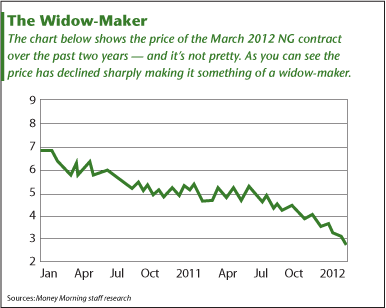It's true: French, Japanese, and Chinese energy companies cannot seem to get their hands on a big enough slice of U.S. shale oil deposits these days.
However, that doesn't mean this investment frenzy is evidence of a "shale oil bubble."
Instead, it's a classic sign of an investment trend – one that will continue throughout 2012 creating an opportunity for investors to profit.
Consider that in just the past two weeks:
- French oil major Total S.A. (NYSE ADR: TOT) invested $2.3 billion in Chesapeake Energy Corp.'s (NYSE: CHK) Utica Shale operation in eastern Ohio.
- China Petroleum & Chemical Corp. (NYSE ADR: SNP), spent $2.2 billion for a 30% stake in five Devon Energy Corp. (NYSE: DVN) shale projects.
- And Japan's Marubeni Corp., a commodities trader, agreed to pay $1.3 billion for a stake in Hunt Oil Co.'s Eagle Ford shale property in Texas.
The Reality Behind the Shale Oil Bull Market
That's a clear sign to investors that interest in shale deposits among foreign energy companies is beginning to heat up.
And to hear the mainstream media tell it, these companies are overpaying for access to U.S. shale deposits.
In fact, they claim that has led to astronomical valuations and the formation of a "shale oil bubble."
But that that perception is actually only half right: While the value of shale deposits has skyrocketed, the reality is that the higher prices are fully justified based on the increasing demands for oil and gas.
What's more, the foreign companies that are paying top dollar for access to U.S. shale assets aren't just paying for access-they're also paying for expertise.
"Foreign majors needaccess to technology andexpertise, as well as being able to putsome portion of reserves on their books," said Money Morning Global Energy Strategist and Editor of the Oil & Energy Investor Dr. Kent Moors. "For that they are quite prepared to farm in for a minority position in development projects."
In return, U.S. energy companies get the investment dollars needed to develop costly and complex reserves.
These foreign investments also give U.S. companies the money they need to acquire more land leases and increase their odds of hitting an especially productive gas or oil reservoir known as a "sweet spot."
That, Dr. Moors says, is where the "bubble" talk comes from.
"U.S. operators cannot afford to under-commit and that has led to an inflation in land prices," Moors said. "Those prices are nowrather out of proportion toa NYMEX gas price of $2.60 per 1,000 cubic feet and hugestorage volume dueto amild winter."
Still, the demand curve for gas will eventually move up as a result of increased usage in electricity generation, replacement of crude oil in petrochemicals, and a renewed emphasis on liquefied natural gas (LNG).
These energy companies, therefore, are taking a medium-term view. In short, they believe that once demand and prices begin to rise, these higher land values will be justifiable.
So where do investors fit in?…

